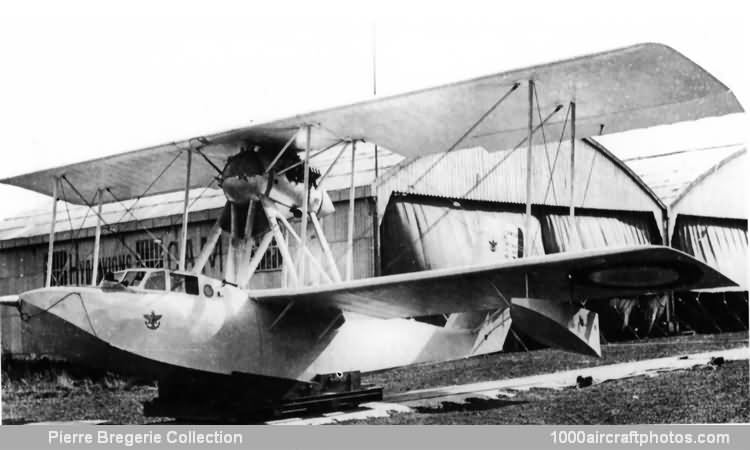12/31/2010. Remarks by Johan Visschedijk: "Of the many elderly seaplanes still serving with the French Navy at the beginning of the WW II, the eldest was the CAMS 37 which had been designed in 1925 by Maurice Hurel of the Chantiers Aéro-Maritimes de la Seine. Intended for both shore-based and shipboard use, the CAMS 37 was entirely of wooden construction and, powered by a 400 hp Lorraine 12 Db twelve-cylinder liquid-cooled V-engine installed as a pusher and braced between the wings, the prototype was flown for the first time at Sartrouville in 1926.
The prototype was known as the CAMS 37 R3b, the R3b suffix indicating Reconnaissance triplace de bord (three-seat), but the second aircraft had a four-blade airscrew in place of the original two-blader, a 450 hp Lorraine 12 Eb twelve-cylinder W-engine, redesigned vertical tail surfaces and an amphibious landing gear, and was designated CAMS 37A. The latter was ordered into production for the French Navy before the end of 1926, a contract for fifteen CAMS 37A amphibians being placed. Shortly afterwards, the Portuguese government ordered seven similar machines powered by the 450 hp Hispano-Suiza 50 (12 Gb) engine.
Several variants of the basic design were quickly produced as further production orders were received, and a commercial model, the CAMS 37C, was evolved, this having the Lorraine 12 Eb engine and an enclosed cockpit accommodating four persons. One of these aircraft was modified as the CAMS 37 GR (Grand Raid) and, between October 12, 1926 and March 9, 1927, was flown a distance of 14,042 mls (22,598 km) around Africa by a French Navy crew. The CAMS 37 GR was subsequently handed over to the Saint Raphael naval air station for communications duties.
The prototype CAMS 37A was handed over to Escadrille 4S1 at Karouba late in October 1928 for training and target-towing, and the first French Navy units to operate the CAMS 37A were Escadrilles 2S1, 3S1 and 4S1, and aircraft of this type were delivered to the cruiser Tourville and the battleship Edgar Quinet in 1929 and 1930 respectively, although the latter vessel passed its flying boat over to the carrier Béarn on August 2, 1930.
The Escadrille du Donnai was formed at Cat-Laï, Indochina, on October 1, 1930, with one CAMS 37 Lia (Liaison), a military liaison version of the civil CAMS 37C later known as the CAMS 37/6, and CAMS 37/2 flying boats, the latter being identical to the CAMS 37A apart from having no amphibious landing gear. This unit was eventually transferred to the French AF as the Escadrille d'Indochine No. 5.
In May 1934, Escadrille 4S1 converted to the larger CAMS 55/2, but production of the CAMS 37 continued at Saint Denis, the principal models being the CAMS 37/2 three-seat observation flying boat, the CAMS 37/6 four-seat communications amphibian, the CAMS 37/9 four-seat transport amphibian (four built), and the CAMS 37/11 (sometimes known as the 37E) non-amphibious basic trainer.
All variants were similarly powered and of similar construction with the exception of the CAMS 37/9 which had an all-metal two-step hull. Variants tested but not placed in production included the CAMS 37/3 observation amphibian with a strengthened hull, the CAMS 37/7 communications amphibian with hydraulically raised wheels, the CAMS 37/12 commercial amphibian, and the CAMS 37/13 metal-hulled ambulance.
By 1935, in addition to Escadrilles 2S1 and 3S1, the Sections de Servitude and Sections d'Entrainement were operating the CAMS 37, one CAMS 37/6 was based aboard the Bearn, two CAMS 37A aircraft were operated by the training cruiser Jeanne d'Arc, and the Ecole de Pilotage d'Hourtin possessed fifteen CAMS 37/11 trainers. However, in the summer of 1936, Escadrille 2S1 converted to the CAMS 55/10, in 1938 3S1 converted to the Gourdou-Leseurre GL-812, and in 1939 the Escadrille d'Indochine No. 5 converted to the Loire 130.
By the beginning of the WW II, the CAMS 37 had been relegated entirely to the training and communications roles. With mobilization, two new units were formed, Escadrilles 2S2 and 2S4 at Rochefort-sur-Mer and Lanvéoc, these possessing four and three CAMS 37/11 flying boats respectively, and despite the fact that these were trainers, the aircraft were used to patrol French coastal waters. Escadrille 2S4 converted to land-based aircraft early in 1940, but 2S2 continued to operate the CA.M.S.37/11 on patrol until disbanded in August 1940.
Escadrille 8S5 based in Tahiti possessed one CAMS 37/11 when it became a Free French unit in July 1940, and continued operating this until January 15, 1941, and another CAMS 37 was reportedly still flying with the French AF in Indochina in 1942."
